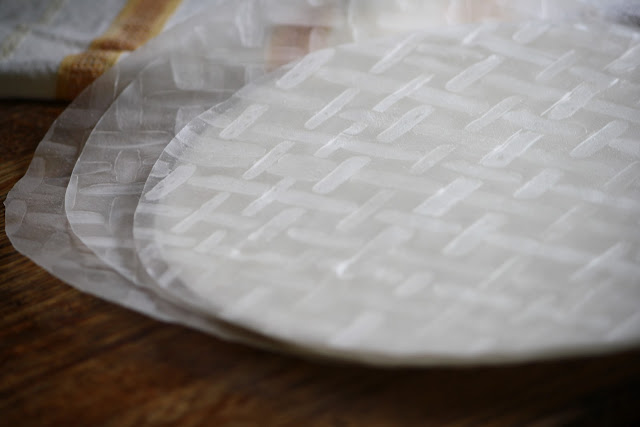Tuyệt vời - That's as close as I can come to the Vietnamese translation for the word awesome. Vietnamese food is my very favorite Asian cooking style, as it relies on fresh, clean flavors and is much lighter than my close second favorite, Thai cooking. Plus the standard combination of mint, lemon grass and basil is just insanely, insanely sexy -- in an herby way. Without even thinking about it, I can tell you that any time I'm lucky enough to get to a Vietnamese restaurant, I always order the Spring (Summer) rolls. I love the look and texture of the the rice paper wrappers, crunchy fresh vegetables, chewiness of the tofu, cellophane noodles and sweet/hot mix of the accompanying sauce. And of course, they're just so pretty. I've made won-tons, pot stickers and egg rolls before, but have never attempted these until today. All I can say is...dayyyam, these are slammin'. Working with rice paper took a little getting used to as it's super thin and very delicate, but after a couple of clumsy tries, I got it down. I hope you will too!
 |
| Map Courtesy of Lonely Planet |
Cuisine in Vietnam is influenced by Chinese, French and Indian traditions. Dishes differ from region to region, but for the most part, fish sauce, shrimp paste soy sauce, rice fresh herbs, fruits and vegetables form the basis for this extraordinarily healthy food. Herbs such as lemon-grass, mint coriander and Thai basil leaves flavor and scent Vietnamese cooking. Unlike Chinese cooking that uses a fair amount of oil, Vietnamese cuisine uses far less oil and relies on fish, chicken, pork beef and seafood for protein. Known for beautiful, healthy vegetarian dishes (influenced by Budhist traditions and values), broths and soup-based dishes are also commonly eaten.
The basics: red leaf lettuce, cucumber, cilantro, mung beans, chilies and daikon
Mint - the stuff that takes over my garden
Julienned carrots and cucumbers
Serrano chili for the Nuoc Cham sauce
Rice paper wrappers (made in Vietnam)
Working on a damp tea towel, lay the rice paper out, then put the lettuce leaf on first then layer the other ingredients - roll into a tight cylinder, tucking the ends in 1/2 way through.
Slice on the diagonal and serve with sauce
Vietnamese Summer Rolls (Adapted from Williams-Sonoma, Asian Cookbook)
8 rice-paper rounds, (12-inches in diameter)
8 red-leaf lettuce leaves, stems removed
2 ounces cellophane noodles, soaked in warm water for 15 min. and drained
1 carrot, peeled and finely shredded
1/2 small cucumber, peeled and seeded, then finely shredded
1/2-lb. block extra firm tofu, cut into 16 slices, each 4-inches long by 1/4-inch thick
1/2 cup mung bean sprouts
Leaves from 1 bunch fresh mint
leaves from 1 bunch fresh cilantro
Working with 1 rice-paper round at a time, soak the round in warm water.
To assemble each roll, lay a lettuce leaf horizontally on the bottom half of the moistened rice paper. At the base of the lettuce place several strands of noodles, 1 teaspoon of the bean sprouts, and several leaves of mint and cilantro. Be careful not to over-stuff the rolls. Lift the bottom edge of the rice paper and carefully place over the noodles and other ingredients, then roll once to form a tight cylinder. Fold in the sides of the rice paper and continue to roll the rice paper and filling into a cylinder.
Place the prepared rolls, seam side down, on a platter and cover with a damp kitchen towel. The rolls can be held at room temperature for several hours before serving.
Just before serving, cut each roll in half at an angle. Serve with Nuoc Cham.
Nuoc Cham (condiment)
3 cloves garlic, chopped
1-1/2 tablespoons sugar
3 tablespoons fish sauce
2 tablespoons rice vinegar
2 tablespoons fresh lime juice
1 serrano chile, seeded and thinly sliced on the diagonal
1 tablespoon grated carrot
1 tablespoon grated daikon
Using a mortar and pestle (or mini food processor_), grind together the garlic and sugar until a paste forms. Transfer to a bowl and whisk in the fish sauce, rice vinegar, lime juice and 1/4 cup of water. Pour through a fine-mesh sieve into a clean bowl and add the chile, carrot, and daikon. Makes about 2/3 cup.
© 2010-2011, What's Cooking in Your World? Sarah Commerford/All Rights Reserved

































